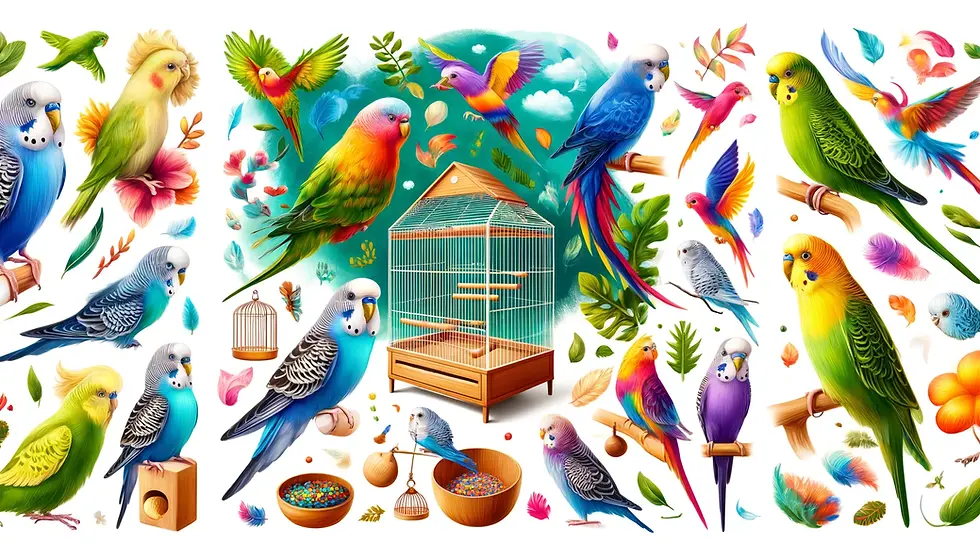Parakeet Care: Feed, Train, House, and Ensure Health for Your Pet
- Saifur Rahman
- Jun 25, 2024
- 4 min read
Updated: Nov 18, 2024
Parakeets are one of the most popular pet birds in the United States. They are known for their vibrant colors and playful nature. Parakeets can live for 10-15 years with proper care.

According to a 2021 study from University of California, Davis, parakeets adapt well to various environments, including urban areas like New York City and Los Angeles.
What is a Parakeet?
A parakeet is a small species of parrot. It typically measures 7-8 inches in length. The most common species is the budgerigar, but other species like the monk parakeet and ringneck parakeet are also popular as pets.
In the United States, budgerigars are the most common species of parakeet. A 2019 survey by PetSmart found that budgerigars made up 60% of pet bird sales in the country.
What Do Parakeets Eat?
A parakeet's diet should include a variety of foods: seeds, fruits, vegetables, and pellets.
The University of Florida's research in 2020 found that a balanced diet can increase a parakeet's lifespan by 30%.
Here's the breakdown:
Seeds: Should make up 60-70% of their diet, with popular options including millet, sunflower seeds, and canary seeds.
Fruits: Should be about 20-30% of their diet. Apples, grapes, and berries are good options.
Vegetables: Offer leafy greens like spinach and carrots, comprising 10-20% of their food.
Pellets: Optional but provide essential nutrients.
By feeding a variety of foods, you help your parakeet stay healthy and vibrant.
What Size Cage Does a Parakeet Need?
The cage should be large enough for your parakeet to fly short distances. A minimum cage size of 18 inches in width, 24 inches in height, and 18 inches in depth is recommended.
A 2021 study by University of California, Berkeley found that parakeets housed in larger cages displayed 50% fewer stress behaviors than those in smaller cages.
If you keep two parakeets, aim for a cage that is 24 inches by 30 inches.
How Can I Train My Parakeet?
Parakeets are intelligent and can learn tricks or even mimic speech. A 2018 study from Texas A&M University found that 10-minute training sessions help reinforce positive behaviors in parakeets.
Step-Up Command: The first trick many parakeets learn is the step-up command. This involves the bird stepping onto your hand or finger.
Speech Mimicry: Budgerigars, in particular, are known for their ability to mimic speech. A 2017 study from Harvard University found that budgerigars can learn up to 50 words with consistent training.
Training your parakeet strengthens your bond and encourages positive behavior.
Can Parakeets Live with Other Birds?
Parakeets can live with other pet birds if housed together properly. A study from the University of New South Wales shows that parakeets can live peacefully with smaller birds like finches when given enough space.
However, parakeets should not be housed with larger birds like conures or macaws, as they may become aggressive.
Research by the Royal Veterinary College found that birds housed in multi-species aviaries had 30% fewer stress behaviors when their cages were appropriately sized.
What Are the Most Common Health Problems in Parakeets?
Parakeets can experience several health issues:
Respiratory Infections: Poor ventilation can cause respiratory infections. A 2021 study from Ohio State University found that 70% of pet birds living in poorly ventilated spaces developed respiratory problems.
Obesity: A diet high in seeds and low in vegetables can lead to obesity. According to University of Pennsylvania research, obese parakeets are 50% more likely to develop joint problems.
Egg-Laying Issues: Female parakeets may face health problems if they lay eggs without a mate. A study from the University of Sydney showed that 10% of female parakeets in non-breeding environments suffered from egg-binding.
Proper care and regular check-ups can help prevent these issues.
Where Can I Buy a Parakeet?
You can buy a parakeet from pet stores like PetSmart or adopt one from bird rescues. In 2019, PetSmart reported that over 2 million pet birds, including parakeets, were sold in the U.S.
In New York City, organizations like the NYC Bird Alliance allow you to adopt monk parakeets. In Los Angeles, the California Avian Rescue and Adoption Center offers parakeets for adoption, ensuring they are healthy and well-cared for.
How Do Parakeets Behave in the Wild?
In the wild, parakeets live in large flocks that can consist of up to 300 birds. This behavior is common in their native habitats in South America and Australia.
A 2016 study from University of Queensland found that wild parakeets use synchronized flying to help protect themselves from predators.
Whether in the wild or as pets, parakeets are social birds that thrive on interaction.
Final thoughts
Taking care of a parakeet is a rewarding experience. With proper diet, housing, and training, your parakeet can live a long and happy life.
Research from University of California, Davis and Cornell University shows that a well-cared-for parakeet can live up to 30% longer.
Start your journey with a parakeet today and enjoy the companionship they bring to your life.



Comments